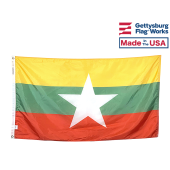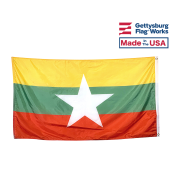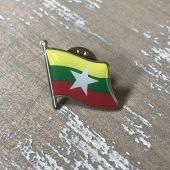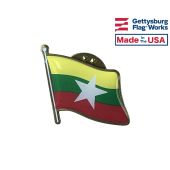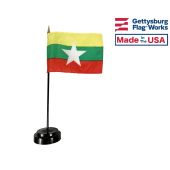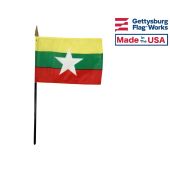Flag of Myanmar (Burma)
-
- Myanmar (Burma) Flag (Old Design) - 3x5' - Header & GrommetsSpecial Price $10.00 Regular Price $54.95
Flag of Myanmar
The current flag of Myanmar is one of the youngest flags in the world, but the country's historical flags are among the oldest recorded flags in Asia. It is common to find a historical flag of Myanmar recorded as a Burma flag, but the two terms are largely interchangeable.
Burma, officially the Republic of the Union of Myanmar, adopted a new state flag on 21 October 2010 to replace the former socialist flag in use since 1974. The new flag was introduced along with implementing changes to the country's name, which were laid out in the 2008 Constitution.
The design of the flag has three horizontal stripes of yellow, green and red with a five-pointed white star in the middle. The three colours of the stripes are meant to symbolise solidarity, peace and tranquility, and courage and decisiveness.
- Capital of Myanmar (Burma): Rangoon
- Area of Myanmar (Burma): 657,740 sq. km
- Languages used in Myanmar (Burma): Burmese
- Religions in Myanmar (Burma): Buddhist, Christian, Muslim, animist
Colors and Symbolism of the Burma Flag
The modern flag Burma is a horizontal triband of yellow, green, and red with a large white star centered in the field. The flag's designer intended the yellow band to represent solidarity, the green band to stand for peace and tranquility, and the red band to symbolize courage and decisive action. The white star on the flag Burma represents the country itself and the importance of the union of its constituent parts.
History of the Flag of Myanmar
The first recorded Burma flag is that of the Hanthawaddy kingdom, a precursor state to the modern nation of Myanmar. It displayed a yellow peacock in profile on a green field. The flag came into use at some point around the year 1300, and remained in use until sometime around 1500. There is a gap in the flag's recorded history between that point and 1752, when the next flag was adopted. Given that the next flag also featured a peacock, it is likely that the bird also featured on the intermediate flags as a symbol of the nation.
The flag of the Third Burmese Empire featured a peacock on a white field. It was a symbol of the nation itself and the Konbaung dynasty that ruled over it, and it fell out of use in 1885 when that dynasty left power. It was not the only flag to be used during that period. Burma became part of British India in 1824, and it also used the Indian flag until it became a separate colony. It received a unique colonial flag in 1939, which was a blue ensign with the Union Jack in the canton and a peacock in place of a coat of arms.
Burma gained its independence in 1943, and the first national flag used the same three stripes as the modern flag with a peacock in place of the star. The peacock was simplified in 1945. Political changes brought about a new flag with a red field and a blue canton with white stars in 1948. The design changed slightly in 1974, and was replaced with the modern flag in 2010.
